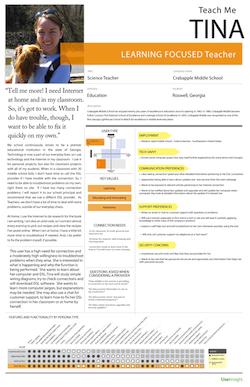Today’s consumers are demanding more from companies. Customers expect products, services, and information that are timely and catered to their specific needs and desires. Traditionally, companies develop and market products based on market segmentation and demographics, assuming that the features, functionality and messaging will meet the needs of all of the customers in that demographic—a “one size fits all” mentality. However, as the marketplace shifts from a mass manufacturing to a mass customization model, customers needs and desires are more accurately identified through the development of personas rather than through demographic data.
 “What Is a Persona?
“What Is a Persona?
A persona represents a cluster of users who exhibit similar behavioral patterns in their purchasing decisions, use of technology or products, customer service preferences, lifestyle choices, and the like. Behaviors, attitudes, and motivations are common to a “type” regardless of age, gender, education, and other typical demographics. In fact, personas vastly span demographics.
How Are Personas Built?
Personas are built by first conducting one-on-one interviews with a wide demographic of the targeted audience(s). Patterns in the data gathered from the interviews begin to emerge after approximately 30 interviews for a typical project focused on one brand or product. These interviews work best when conducted in-context, such as the respondent’s home or place of work. This way, ethnographic research techniques may be employed to gather information about the users’ environments, providing insight into their behaviors, motivations, and attitudes that may not otherwise be uncovered in a survey, focus group, or one-on-one interview in a market research facility. Typically, the researcher begins with a broad conversation that ultimately narrows in on the use of specific products or services.
Analysis is then conducted on the research data over the course of one to two weeks. The researchers identify extremes in user behavior and group similar respondents together. Patterns of behavior define each user type and provide a clear understanding of how they relate to each other within the extremes.
From here, it’s essential to launch another round of research. This time, the recruiting is done according to the behavior and motivation criteria that represent each user type, rather than by the demographic criteria used in the first round. Recruiting five to seven respondents per persona is sufficient to see patterns of behavior. Recruiting additional users may offer some additional insights, but rarely enough to justify the cost. It’s possible to conduct these interviews in a market research facility, or even online; however, qualitative data and observations are always more robust when gathered in context.
This round of research validates the persona characteristics and fills in any gaps from the first round of research. More importantly, this is an opportunity to ask specific behavioral questions to better understand how the personas relate to products and messaging. This yields valuable information on how to customize the user experience to specific types of people based on their attitudes, behaviors, and motivations, regardless of demographic information.
Where Does Persona Development Begin?
The first step is to define the customer lifecycle and understand all of the corresponding touchpoints. Each touchpoint will have a corresponding key department that must understand the personas in order to provide an optimal customer experience. Getting buy-in from leadership within each department early in the persona process is key to socializing the personas—spreading the knowledge of the company’s customers throughout the organization.
It is a common mistake to wait until the personas are finalized before beginning the socialization process. Socialization attempts within an organization without buy-in are often met with resistance. Getting all of the key stakeholders involved early in the process involves them in informing the initial understanding of the customer and, therefore, helps define the research. Informing these stakeholders of the project’s progress will keep them interested, provide opportunities for feedback, ensure a higher quality persona deliverable, and generate greater buy-in throughout the organization.
If there isn’t buy-in or, at the very least, usage of the personas across multiple divisions of an organization, the success and longevity of the personas will be limited. The company may create great products based on the personas but lose customers on poor acquisition, unresponsive customer support, or other problematic areas of the customer lifecycle. A consistent and customizable user experience across the entire customer lifecycle is the key to adoption, usage and loyalty, increasing ROI exponentially.
What Is a Typical Persona Investment?
There is no shortcut to creating personas; they are an investment. Strategic, forward-thinking organizations can build personas as a subset of other research, but when conducted properly as a standalone project, the investment in persona development is somewhere between $80,000 to $120,000.
Full-fledged personas must go beyond the demographic data. Demographics are temptingly easy to collect from various sources in an organization, but persona work yields a much deeper understanding of why customers do the things they do and what they expect from an organization within any given context. This knowledge about customers’ motivations (the why) makes it possible to create innovative solutions, products, ad campaigns, and customer support (the what) that cater to customers on a personal level.
Some advertising and design agencies offer inexpensive, shortcut methods of defining personas, but these marketing profiles lack the specificity and substance of true personas. An inability to plot the personas in relation to each other and heavy reliance on demographic data for the interpretation can be indicative of personas done on the cheap.
Good personas make the difference between doing the upfront work to get it right the first time rather than spending the same money or more with multiple redesigns, increased customer support costs, etc.
How Can Companies Optimize Their Investments in Personas?
Personas can and should be shared and utilized across the entire organization, and within various product development, marketing, customer support, and sales departments. Each department can use this persona information; for example, product managers can use the information to design a product that better meets the needs or desires of a particular persona, and marketing can use them to craft messaging that resonates. Holding such rich customer information within just one business unit because of political struggles and posturing within the organization is the quickest way to lose the investment in a persona project. Sharing and maximizing the persona work across divisions increases the realization of an ROI and the initial research costs can be shared across different budgets.
Personas should also be updated frequently. Innovation and competition may significantly shift the attitudes and behaviors of a company’s customers. In order to keep personas current, companies should maintain a consistent dialogue with customers and commit to maintaining the personas as living and breathing documents. A centralized process for communicating new user research and updating the personas accordingly is critical.
What Can Companies Do If They Don’t Have the Budget for Full-Fledged Personas?
If a company is collecting behavioral or qualitative data on its customers, it can spend some time and money mining that data to get a strong understanding of who its customers are and why they do what they do. Such data can help to inform the persona research and can reduce the costs.
Companies that conduct regular research on their products can piggyback that research with specific questions about behaviors and attitudes. While it will take longer to get answers this way, it’s at least possible to leverage other research dollars to eventually get to a base understanding of the personas.
If there hasn’t been any meaningful initiative to collect qualitative data on customers, it will be necessary to begin a persona project by conducting 24 to 36 contextual interviews with customers. This can be done over the course of three to six months rather inexpensively using a consultant for about $35,000. This will not yield full-fledged personas, but it will start to reveal clustering and patterns of behaviors that will inform user types.
These user types can, in turn, be leveraged in every type of customer feedback initiative going forward. The company can build upon this knowledge until, finally, enough information has been compiled to cluster the customers into personas.





